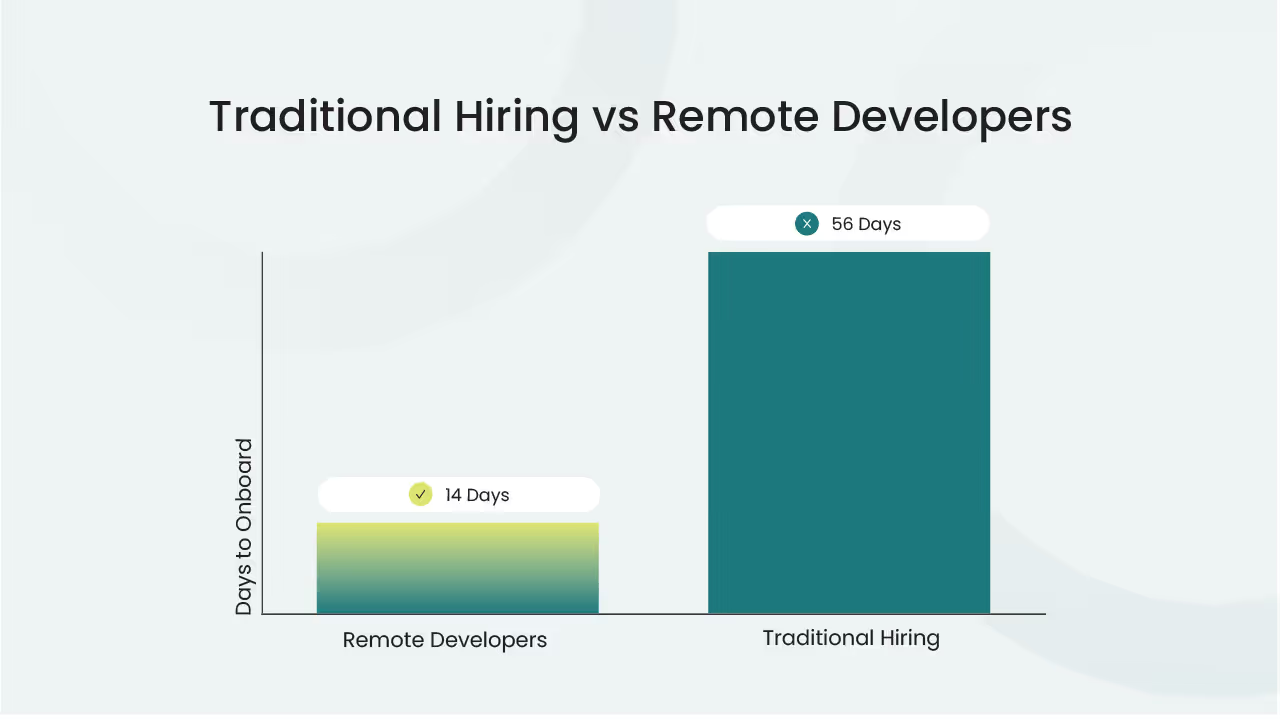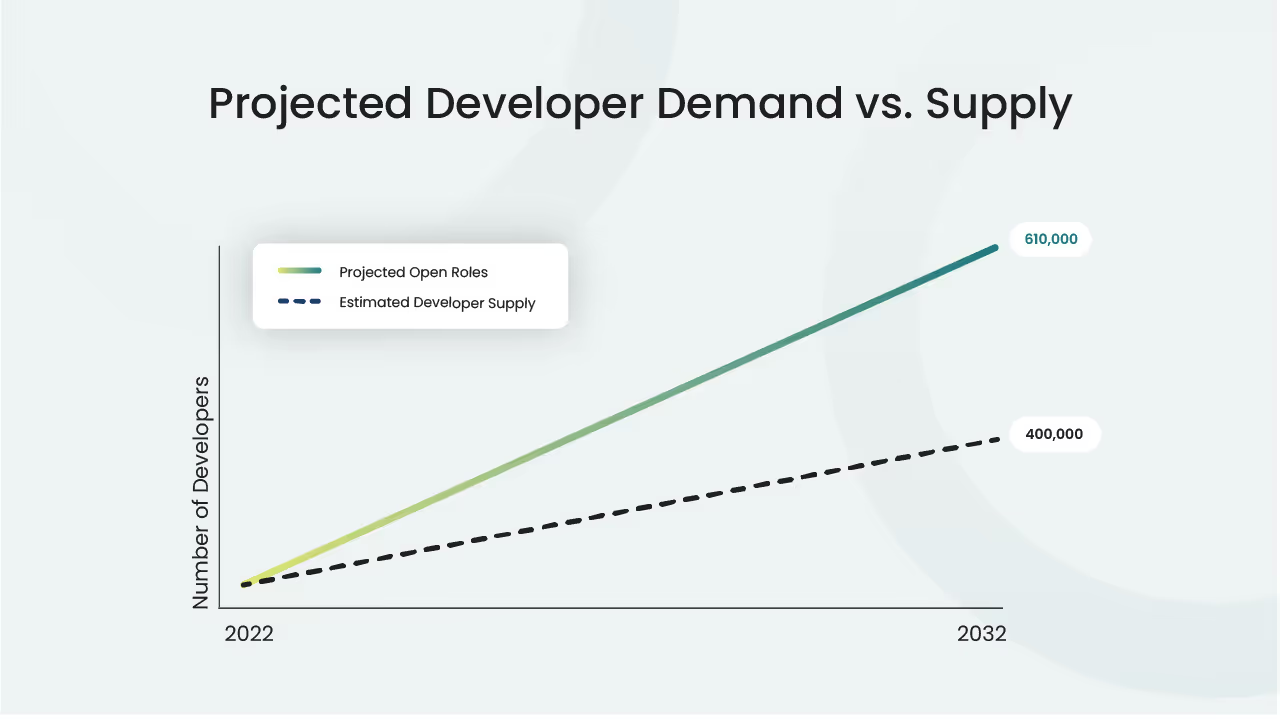Scaling Product Development with Remote Software Developers
.avif)
📌 TL;DR
Local hiring is too slow and costly. Remote developers solve this with faster onboarding, specialised skills, and cost efficiency. When embedded into workflows as dedicated team members, they give leaders the flexibility and resilience to scale quickly without losing quality. Explore lessons from the field with Cloud Employee CTO Anto Čabraja.
Why Remote Developers Are Now a Scaling Imperative
For modern product leaders, scaling is no longer a “nice to have”, it’s survival.
Investor pressure to deliver faster, competitive markets that punish delays, and an increasingly global user base mean engineering teams must be able to expand at speed.
Yet traditional hiring can’t keep up. Average U.S. time-to-fill for IT and development roles hovers around 56 days, a timeline that can derail ambitious roadmaps (Recruiting Resources). Meanwhile, the median U.S. software developer salary is approximately $133,080 USD per year (Bureau of Labor Statistics, 2024).

That’s why forward-thinking founders and CTOs are increasingly turning to remote software developers. These are professionals who design, build, and maintain software while working entirely outside of your physical office. Whether based in another U.S. state or halfway across the globe, they collaborate with your team in real time (or asynchronously) through tools like Jira, GitHub, Slack, and Zoom.
And in 2025, remote developers aren’t a backup plan, they’re a strategic accelerator. The combination of talent scarcity, rising specialisation demands, and the permanence of remote work has made them a core part of the scaling toolkit for high-growth tech teams.
Why Remote Developers Are Now a Scaling Imperative
The Talent Gap Is Real
In the U.S., software engineering remains one of the fastest-growing occupations, projected to grow 17% between 2022 and 2032, adding over 327,000 new roles (Bureau of Labor Statistics, 2024). The problem? The supply of senior, specialised engineers isn’t keeping pace, especially in high-demand areas like cloud-native architecture, C#, and AI systems.

Speed and Agility Bead Headcount Alone
When deadlines are looming, the speed at which you can add skilled contributors can make or break a roadmap. Bringing on a dedicated remote developer, or team of remote software developers in as little as two weeks can be the difference between shipping on schedule or slipping a release cycle.
Remote Work Is Here To Stay
Gallup reports that half of full-time U.S. workers now have remote work options, and 60% say they would consider leaving if those options were removed (Gallup, 2024). For developers (who often have multiple job offers) remote flexibility is now a baseline expectation. Leaders who embrace distributed teams gain access to talent others miss.
Balancing speed and quality is the core challenge when scaling with remote staff. To move fast, teams often cut back on processes like documentation or testing, which works for a core group but breaks down with new hires who lack context. This is where the pressure mounts: you need engineers who can adapt quickly, follow standards, and integrate without slowing momentum.
Finding such talent is difficult, which is why staff augmentation with CTO-level vetting is so valuable. It delivers developers who are ready to contribute from day one, keeping both speed and quality intact.
The Case for Scaling with Remote Software Developers
Scaling product development with remote talent offers more than a quick fix, it’s a structural advantage when executed strategically.
- Speed to Market
With the right partner, you can onboard niche-skilled developers (whether C#, React, or Go), in days rather than months. That translates into faster feature releases, accelerated MVP delivery, and fewer delays in meeting customer demand. - Access to Specialised Skills
Local hiring pools often lack depth in emerging or niche stacks. Remote developers open global access to exactly the expertise you need, from AWS DevOps engineers to React Native specialists. - Cost Efficiency Without Compromise
Strategic hiring from high-talent, lower-cost regions allows companies to optimise budgets without sacrificing quality. This approach can drastically reduce staffing costs, while maintaining delivery speed (check out our price comparison tool to understand this further). - Lower Risk with Dedicated, Pre-Vetted Talent
Unlike gig-based models, dedicated remote developers are embedded in your team, aligned to your processes, and committed long-term. At Cloud Employee, all talent is pre-vetted by me (CTO) or senior engineers, using a process I have designed, and implemented with input from our senior engineers. In my role I oversee the process, but the actual vetting is carried out by the engineering team. This ensures that we’re testing for technical ability and cultural fit before onboarding, ensuring the right hire from day one.
Strategic Resourcing Models for Scaling with Remote Developers
Scaling isn’t just about adding headcount, it’s about structuring your team for sustained velocity. For tech leaders, there are three proven ways to leverage software development outsourcing services while maintaining product momentum:
- Dedicated Developer Pods
Small, cross-functional teams of dedicated developers (often including a remote front end developer, a remote back end developer, and a QA lead), working exclusively on your product. They function as a parallel sprint unit, integrated with your in-house processes. - Specialist Augmentation
Targeted hires for urgent skill gaps. Need a C# backend engineer to stabilise a legacy system or a React Native dev for a mobile release? Specialist augmentation lets you plug in talent fast without committing to permanent hires. - Blended Teams
Combining in-house leadership with offshore execution. Your product managers and architects stay close to strategy, while dedicated remote developers handle delivery at scale.
Cloud Employee’s staff augmentation approach sits firmly in the dedicated developer category. Unlike typical outsourced software development services where your resources are shared, our engineers work exclusively for you, embedded in your workflows and reporting lines, just as if they were in the next room.
Lessons from the Field — Real-World Scaling Stories
Case Study: Salmon Software
A treasury management leading organisation, needed to accelerate its move from a long-standing desktop product to a modern SaaS platform but faced major hiring delays in its local market. By partnering with Cloud Employee, they built an 11-person Manila-based team in just six weeks - including Senior Full Stack .NET Developers, Senior Azure DevOps Engineers, and specialists in systems engineering and performance.
The result? SaaS roadmap momentum without disrupting core operations - modernised architecture, smoother delivery, and a culturally aligned team backed by ongoing support.
Case Study: Event Connections
An event services provider, Event Connections, needed to modernise its custom-built platform but struggled to hire experienced .NET developers in the UK’s competitive market. Using Cloud Employee’s outsourcing model, they onboarded a team of three dedicated .NET developers in just two weeks, all embedded seamlessly into day-to-day operations. The result? A faster platform rebuild, freed-up internal resources, and the adoption of new technologies.
These examples show how IT outsourcing when done with a dedicated, embedded team, can feel as seamless and accountable as in-house work, but with the scalability and cost efficiency of outsourced IT services.
Outsourcing vs. Building In-House: The Strategic Choice
When deciding whether to scale in-house or leverage outsourced software development services, tech leaders must weigh:
- Control: In-house offers maximum oversight but demands longer hiring timelines and higher fixed costs.
- Flexibility: IT outsourcing allows rapid scaling but risks cultural misalignment if using low-quality vendors.
- Cost Structure: Building in-house locks in salary, benefits, and overhead; outsourcing offers a variable cost model.
Staff augmentation (Cloud Employee’s model) combines the best of both. You gain the flexibility and talent reach of software development outsourcing, but with dedicated developers who work exclusively for you, report directly to your leads, and are pre-vetted by senior CTOs.
Why ‘Dedicated’ Remote Developers Reduce Scaling Risk
Not all outsourcing is created equal. The dedicated remote developer model mitigates common risks by ensuring:
- Pre-Vetted Quality – Every hire passes technical and communication assessments conducted by Cloud Employee’s senior engineering leadership.
- Exclusive Focus – Developers work solely on your project, avoiding the split priorities that plague agency and gig-based models.
- Continuity – Long-term placements mean deeper product familiarity, knowledge retention within your teams, less onboarding overhead, and consistent delivery.
- Seamless Integration – From day one, your dedicated developers use your tools, attend your standups, and align with your culture.
For companies asking how to outsource software development without losing control, this approach offers the best of both worlds: the reach of software development outsourcing services and the stability of a committed, in-house-like team.
Best Practices for Leading a Remote Product Development Team
Even with the right hires, leadership is the multiplier. High-performing remote teams share these traits:
- Strategic Sprint Planning – Go beyond task allocation by aligning every sprint with clearly defined business outcomes. This prevents overloaded backlogs and ensures developers understand not just what they’re building, but why. With the right structure, sprint planning becomes a training ground for critical thinking and leadership within the team, helping engineers contribute solutions rather than simply execute tasks.
- Async-First Communication – Leverage tools like Jira, Loom, and Confluence to manage time zones and reduce meeting fatigue. Prioritize written, transparent updates that give every team member (senior or junior) equal access to context and clarity.
- Embedded Culture – Actively involve remote developers in retros, demos, and all-hands meetings. This creates a sense of shared ownership and prevents the “outsider” dynamic that erodes motivation and alignment.
- Impact-Based Measurement – Shift evaluation from hours logged to outcomes achieved: delivered features, platform stability, and user feedback. This approach reinforces value creation and gives teams a shared yardstick for success.
Many teams overload themselves with tasks or try to solve things on the fly, but without structured sprint planning, new or less-experienced developers lack visibility into the bigger picture. That creates gaps in alignment and unrealistic expectations. When sprints are tied directly to business outcomes, the team not only delivers more effectively but also builds trust, confidence, and a culture where engineers feel empowered to think critically and contribute solutions, not just execute tasks.
Scaling Without the Growing Pains
Scaling with remote developers isn’t just about cost savings, it’s about agility, resilience, and staying ahead of market demand.
The lesson from the field is clear: the right resourcing model, combined with vetted, dedicated talent, can transform your delivery velocity without compromising quality.
If you’re looking to scale your team without the hiring bottlenecks, churn risk, or quality trade-offs, Cloud Employee can help. Our developers are handpicked by our senior engineers and CTO (me), are fully dedicated to your project, and integrated into your processes from day one.
Let’s talk about building your dedicated remote team and hitting your next milestone faster.
FAQs
Dedicated developers work exclusively on your project, integrated into your workflows, unlike traditional outsourcing where resources may be shared.
Through a pre-vetted talent partner like Cloud Employee, you can onboard in as little as two weeks.
Yes. With proper onboarding, they can participate in daily standups, sprints, and retrospectives like any in-house team member.
Rates vary by region and experience, but dedicated remote hiring models often deliver 30–50% cost savings over local hires.







